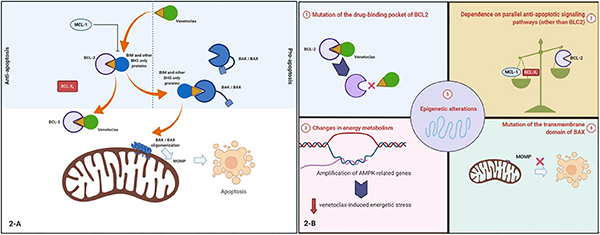Figure 2.
A: proposed mechanisms of resistance to venetoclax in acute myeloid leukemia (AML); B: see text for details: (1) mutations of direct drug-target binding pockets on BCL2. This proposed mechanism has been extrapolated from observations in chronic lymphocytic leukemia; (2) over-expression of MCL1 or BCLXL can cause resistance. For instance, BIM that is released from BCL2 with venetoclax monotherapy can be sequestered by MCL1. This can be reversed by combining venetoclax with cytarabine or daunorubicin, which upregulates the MCL1 binding partner NOXA, or using a selective MCL1 inhibitor; (3) changes in energy metabolism. For instance, upregulation of fatty acid oxidation that may help provide metabolic plasticity to AML cells; (4) mutations of the transmembrane domain of BAX leading to a decrease in BAX-induced MOMP and apoptosis; (5) epigenetic alterations. For example, HOXA and HOXB genes are highly expressed in highly sensitive samples while resistant samples have little or no expression. Figure was created with BioRender

